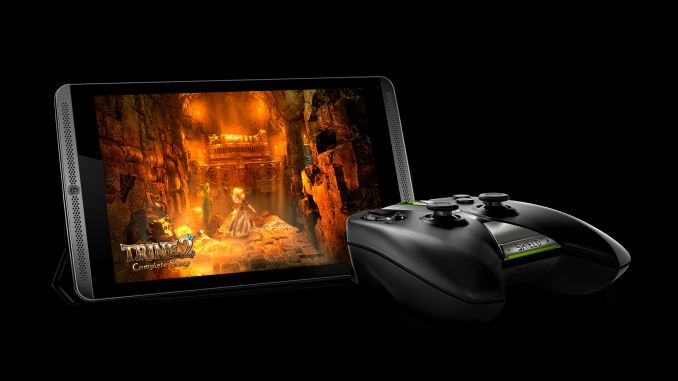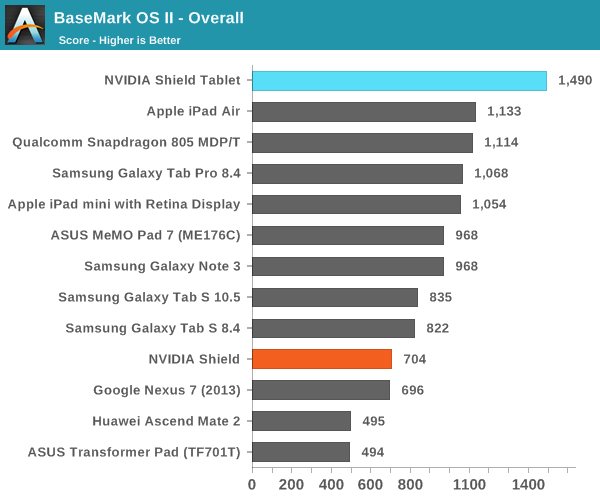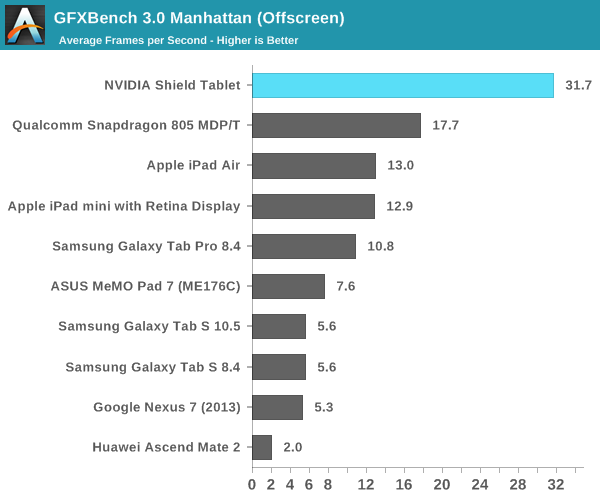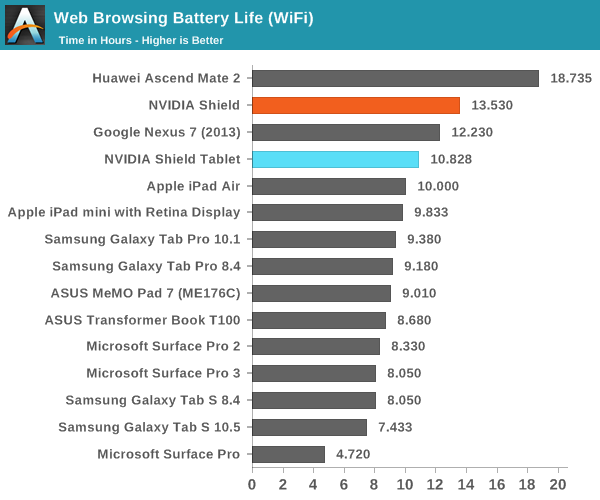Short Bytes: NVIDIA's SHIELD Tablet
by Jarred Walton on July 29, 2014 1:38 PM EST
Today's launch of the new SHIELD Tablet with NVIDIA's Tegra K1 SoC has muddied up the tablet waters a bit. We've posted our full coverage of the device, but for those looking for a short summary of the SHIELD Tablet – and whether it's worth buying or not – here's the synopsis of NVIDIA's latest entry into the mobile gaming market.
At its core, the SHIELD Tablet is a fully functional 8" Android tablet, which is quite a change from the initial SHIELD handheld gaming device. Of course it comes with NVIDIA's latest Tegra K1 processor, a quad-core ARM Cortex A15r3 CPU with a 192 CUDA core Kepler-derived GPU and 2GB DDR3L-1866. Storage options are currently 16GB or 32GB, and a microSD slot for additional storage. The display is a 1920x1200 IPS panel, and though it has a somewhat limited color gamut it's a decent if not exceptional display overall. Connectivity consists of 2x2 stream 802.11n WiFi and Bluetooth 4.0, with optional LTE support also available. The 16GB model comes with WiFi only while the 32GB model is equipped with LTE. A capacitive DirectStylus 2 also comes standard on both models.
The overall build quality and design are definitely improved over the Tegra Note 7, with a premium feel that was previously lacking. In many ways, it feels like a larger variant of the Nexus 5, and as an owner of a Nexus 5 that's pretty high praise. NVIDIA has also provided stereo front-facing speakers that sound better than those in most tablets. The only problem is that the SHIELD Tablet is rather heavy compared to the competition – it weighs 390g, compared to 294g for the Samsung Galaxy Tab S 8.4, but you get better performance with the added weight.



While there's certainly plenty of hyperbole involved with NVIDIA referring to the K1 as having supercomputing roots, from a pure performance perspective the K1 GPU delivers the goods, topping the charts in most of our graphics benchmarks. The CPU side of the equation isn't quite as impressive; it's faster than the previous generation Tegra 4, but given differences in platform, OS, etc. it can be difficult to draw firm conclusions. In general, you can expect somewhere around 5-25% better CPU performance than the Tegra 4, and the K1 tops most of the CPU charts and is at worst competitive with other leading SoCs. About the only potential weaknesses are in the NAND performance (random write is a bit low), and battery life takes a step back from the earlier SHIELD (though that's with a smaller battery) – and under heavy gaming workloads it can be less than three hours depending on the game. That's sort of the price you pay if you want maximum gaming performance from a tablet, though: battery life is going to take a hit when running full tilt.
NVIDIA has put quite a bit of effort into the software side of things as well. Besides all the usual Android tablet features – which basically work as expected – you get ShadowPlay support (record and/or stream your gaming sessions), GameStream (either local or remote is in beta), and access to GRID gaming as well. We've covered all of these previously, and there's nothing really new to add: they all work and offer features that you can't find on other tablets. If you're in the market for a tablet that can function as a portable gaming system, your options are quite limited.
The base price for the SHIELD Tablet is actually quite good, all things considered: $299 will get you one of the fastest Android tablets around, but don't forget the accessories. There's the DirectStylus 2, SHIELD wireless controller, and SHIELD Tablet cover. While you get a DirectStylus 2 with every SHIELD Tablet (a replacement stylus will set you back $20), the wireless controller is a $60 accessory and the magnetic cover is another $40 accessory. The cover isn't strictly necessary, but as someone that has used quite a few tablets without covers, over time getting some sort of cover is highly recommended, and the SHIELD Cover is a high quality cover that meshes well with the tablet. The wireless controller is a different matter: if you're looking at this as a gaming device, it's basically a required accessory. There are many Android games that are designed for a touchscreen, but if you want to use GameStream or play any of the games optimized for a gaming controller, you'll need the SHIELD wireless controller.
Taken as a complete package, then, you're looking at $400 for the 16GB WiFi model with accessories and $500 for the 32GB LTE model. You can argue that's too much, and I wouldn't necessarily disagree, but if you like the idea of a portable gaming tablet you don't really have many other choices. You can get the older NVIDIA SHIELD for $200, but that's half the price for basically half the performance and it was never really that useful except as a gaming device. The SHIELD Tablet on the other hand can function perfectly well as a tablet, and you only need to bring out the controller for times when you want to play games.
Ultimately, the SHIELD Tablet is a far more versatile solution than the original SHIELD, and if you're in the market for a new tablet it's still worth considering even if you don't care much about the gaming aspects – you can always add the controller at a later date. It might be a bit heavy compared to other options, but the performance and features definitely help set it apart. Unless you're particularly committed to a specific vendor for your devices, the SHIELD makes for a good addition to the Android family.
















32 Comments
View All Comments
jjj - Tuesday, July 29, 2014 - link
Made a comment about the size somewhere on AT,trying to look at volume over similar tablets and you can even look at volume per screen area to factor in differences in scree sizes and AR. If you compare it to the Tab S 8.4 the Shield is quite huge not just heavy.For a mobile device,mobility is important, for a pocketable device even more so and 8 inch is pocketable for some.
No wifi ac , not great screen and no emmc 5 are not exactly a plus.
As for the price,300$ is just too much for any 8 inch tablet ,even if it was high res. Sure some are pricing their products well above that, but that's no reason to accept it as reasonable. You also got a bunch of A53 based SoCs from Qualcomm, Mediatek , Marvell and a bunch of A17 and A15 based SoCs from Mediatek, Rockchip and Allwinner.all arriving now. Qualcomm actually just said they'll launch the 810 this year, no idea if launch means ship or devices in stores( my bet is on the Nexus phone to be using it but remains to be seen)
So no thanks,as a tablet is so not good enough, as a gaming tablet maybe it is but not very sure Nvidia should aim to make just a gaming tablet. I've been waiting for a while for a good enough tablet and was looking forward to this one so it was a rather huge let down. Guess i'll end up with some China tab that makes a lot more sense.
If it was 250$ and a lot more compact it would be lovely , if it was same body just thinner and 8.8 inch screen at 300$ i would have at least considered it as an option.
ArthurG - Tuesday, July 29, 2014 - link
Everyone has his own opinion but I don't agree with yours. For me, the price is well positioned. It's really easy to forget the incredible performance and say that every other parameter is meh. But no, SHIELD Tablet is, before anything else, the fastest Android device, and not by small margin, but more than 2 times faster than the closest competition on the heavy Manhattan test. The price is very cheap for this performance, and other parameters are very descent, so I'm ordering one, like many people on Amazon (in Top 5 bestseller tablets now)jjj - Tuesday, July 29, 2014 - link
The performance is not just the GPU , and the SOC is just a 25-30$ part and being the fastest today means little especially when you might be way slow in just a few months (Snapdragon 810 is quad A57 plus quad A53 and cat 6 LTE on 20nm. A57 is supposed to be quite a bit faster, 20nm adds quite a bit more to that and then software optimized for V8 even more). Other SoCs that are showing up might not be that slow compared to TK1 and you don't really have the software for TK1 anyway while the tablet is just 1200p.Then if you want TK1 for w/e reason ,there is the Xiaomi Mipad with higher res screen and similar price for western buyers but prices will drop a bit when there will be better supply. That one is 4:3 so maybe a deal breaker for many. And there will be other TK1 devices ofc. Sure they might not have some of the gaming but i stated in my comment that it's not good enough as a tablet but might be as a gaming tablet.
mutil0r - Tuesday, July 29, 2014 - link
But isn't that also applicable to other SoC vendors? The S810 (which is still more than a few months away) will, within a few months of its arrival, be supplanted by whatever Intel or Nvidia push out next.Heck, if TK1's performance is anything to go by, you can be certain that Nvidia's Erista with a Maxwell gpu will likely destroy whatever Qualcomm or Intel have in store. Looking at what Nvidia has with them now and what will be available next year, Erista will likely be maxwell paired with some evolution of Denver or maybe A57/A53 combo.
Fact of the matter (as hard as you find it to believe) is that this tablet is awesome, especially for the price. Do I want more for my money? Obviously...who doesn't. But that does not mean Shield tablet is lacking or bad in any way.
jjj - Tuesday, July 29, 2014 - link
As i understood your comment ,you suggested it deserves some kind of significant premium because it is very fast and i don't agree with that. Now ,this is not about the SoC anyway, it is about the tablet. Yes the SoC is rather exciting today and i would love a tablet with it but not this one.The fact is that it's like 45% bigger ,volume wise, than the Tab S 8.4 if we look at a very compact tablet as the benchmark. It also has a 10% smaller screen by area and you can find better value elsewhere.maybe not at Best Buy but that's not a problem. And it is lacking , it is lacking wifi ac , it is lacking in screen quality it's by no means high end,corners have been cut. And the bulk is bad ,over 9 mm thick today is ridiculous.
ArthurG - Tuesday, July 29, 2014 - link
Again it's you opinion and you can't expect anybody to agree with you.Tab S8.4 ? GPU slow as hell with Touchwiz crap UI that is a total no go. it can be as thin as it wants but it doesn't suit me.
On the other side, if I want max performance that will permit me to play Android 3D games for the next 2 years, with stock android and timely updates, then SHIELD tablet is the best choice.
jjj - Tuesday, July 29, 2014 - link
As i said this is not about the SoC, it's about the package and this is not hte only Tegra K1 product we will see. Right now it's just this one and the Xiaomi but we'll see more and even now the Xiaomi is 240$ in China (300 more or less outside but that price will drop) while having higher res and wifi ac.The comparison with the Samsung was about size and what others are doing when it comes to ergonomics/design.And if you cared about the long term you would wait for 64 bit SoCs on 20nm not go for anything on the market now.You got excited about the SoC and you are ignoring everything else. Yes the SoC is rather exciting but Nvidia should have done a lot better with the tablet. This is not a Nexus gen one moment or first Amazon tablet moment but it could have been given how exciting the SoC is and how terrible the Android tablet landscape is right now (outside China i guess ,since there things are much better). Last year we had no great tablet launched when factoring in the price too, nothing really exciting, even the Nexus was rather daft and sales are in line the products available to us. World wide tablet sales have slowed down in a big way, When it comes to Android gaming ,it would have mattered a lot if this SoC would have sold really well , devs are not going to invest in games for it if there isn't a big install base. Would be nice to have better Android games but this is not going to do it. In the end if Nvidia was only interested about promoting gaming they would price it at 200$ and make no money on it , they could have made a better device,sell it cheaper and make more money on volume but this just seems a missed opportunity.
Morawka - Tuesday, July 29, 2014 - link
I read all of your responses, and to be frank, your totally missing the point of how versatile of a device this is.This device can be used for the following:
* Tablet for surfing the web and playing games
* Roku 3 box for your tv with better performance or i should say Amazon Fire box since it has voice control.
* A Mobile Netflix station with the best speakers ever put into a tablet, with native 1080p streaming.
* WebTV Box for surfing the web on your tv (complete with mouse cursor and keyboard via bluetooth)
* Gaming Console for travel, Both Android games and Nvidia K1 games (the list will get bigger this year)
* Brings your PC Gaming to any room that has a TV in your house (via hdmi out)
* A digital art tool for painting and drawing
* A One Note machine for annotating pdf's or any other document
* A Skype station with amazing front facing camera and stereo front facing speakers
* A mobile Plex Media Server with 128GB micro SD card support and USB OTG support for External HDD's
* A mobile SNES, N64, PSP, PS2, Emulator Station with low latency controller (none of that bluetooth crap)
* A Universal Remote with apps (this is the tablet to take to bed with you)
My point being, sure it could be slimmer, and sexier, but this is a feature heavy tablet that is 100% the most versatile tablet in this price range.
jjj - Tuesday, July 29, 2014 - link
haha you must be related to the Comcast call from hell guy.Dylansdad - Tuesday, August 5, 2014 - link
LOL. Dude, seriously. You are clueless.